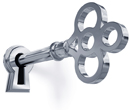Lesson 2
1. Lesson 2
Module 3: Permutations, Combinations, and the Fundamental Counting Principle
Lesson 2: Factorial Notation
Focus

iStockphoto/Thinkstock
Sierra is playing an online game called “Win That Car!” She is presented with four virtual keys and four doors. Each key is a different colour. If she puts the correctly coloured keys into the correct doors, she wins the car. Once she has used a key, she cannot use it again. How many ways can she put the keys in the doors? ![]()
As you saw at the end of the last lesson, factorial notation is mathematical shorthand for writing out the product of consecutive natural numbers and it is used when determining the number of arrangements of objects.
Lesson Outcomes
At the end of this lesson, you will be able to
- calculate the number of arrangements of items using factorial notation
- simplify algebraic expressions involving factorials and use this in solving equations
Lesson Questions
In this lesson you will investigate the following questions:
- How many arrangements of n distinct objects are present when they are arranged into a sequence containing all n objects?
- How are algebraic expressions involving factorial notation simplified?
Assessment
Your assessment may be based on a combination of the following tasks:
- completion of the Lesson 2 Assignment (Download the Lesson 2 Assignment and save it in your course folder now.)
- course folder submissions from Try This and Share activities
- additions to Glossary Terms
- work under Project Connection